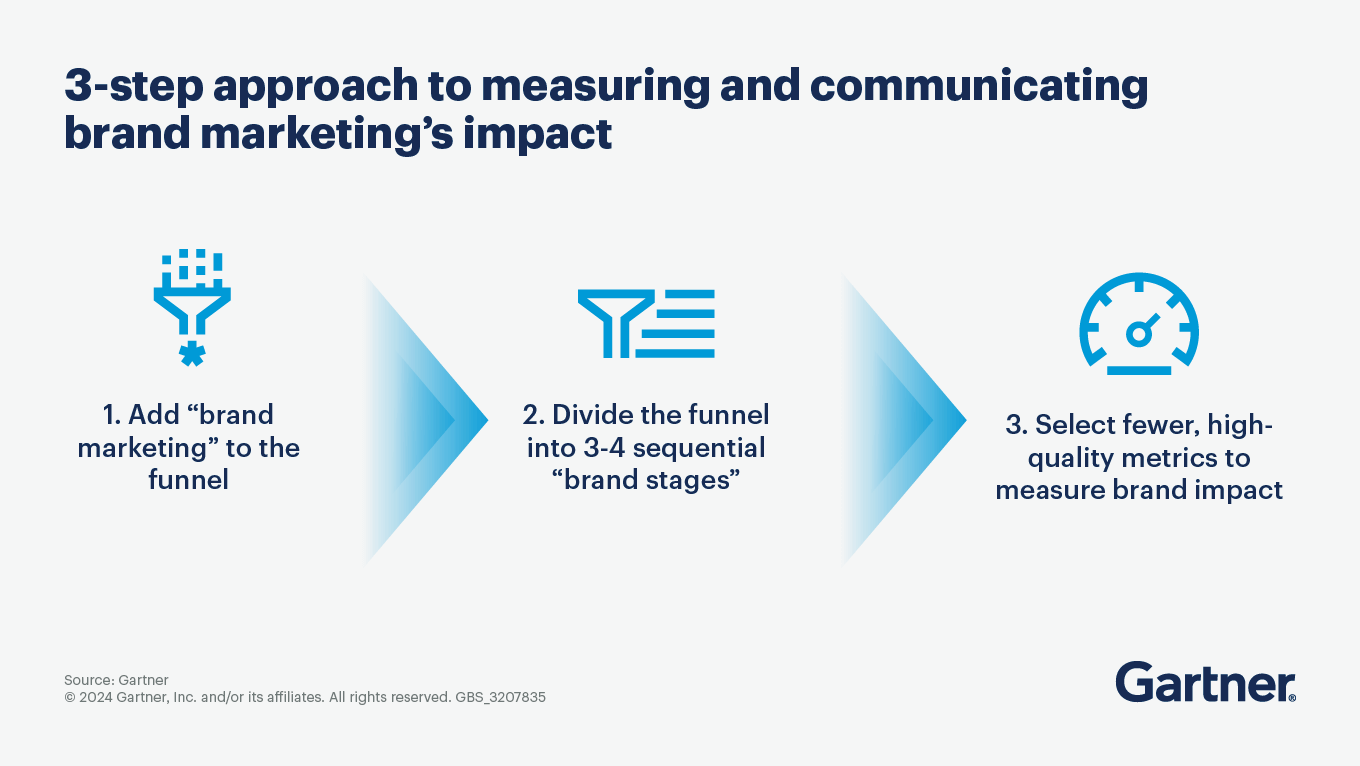Consider brand awareness as but one component of brand marketing to showcase the value of your investments.
- Gartner client? Log in for personalized search results.
Reframe Brand Awareness to Prove Marketing's Value Internally
By Alex De Fursac Gash | October 11, 2024
Brand awareness as an important first step toward business growth
CMOs are responsible for demonstrating the vital connection between brand marketing, demand generation and desired business outcomes — that is to say how investments in brand commercially impact their organization. Brand awareness and brand marketing are not one and the same, but brand awareness is a small yet necessary component of brand marketing.
Consider brand awareness as one important stage of brand marketing — the former is key to getting the latter right, and making the case for brand investments.
How to show the connection between brand awareness and the bottom line
The Gartner 2024 CMO Spend Survey shows that brand marketing budgets across industries have seen a sharp decline over the past five years, dropping by more than 40% as a proportion of total revenue.
Many organizations continue to struggle to justify the fiscal case for building brand awareness and brand marketing, often relegating them to secondary importance behind funnel marketing (i.e., consideration and conversion), which the CEO, CFO and the board perceive as delivering more immediate and measurable results.
Step 1: Integrate brand into the marketing funnel
To elevate the internal perception of brand awareness and its umbrella, add brand marketing directly into the traditional funnel. Improving brand recognition shouldn’t be viewed as a stand-alone investment but as part of the total marketing budget. By placing brand at the top of the funnel, you establish it as a long-term enabler of consideration and conversion efforts.
With brand marketing in the funnel, you are equipped to demonstrate a holistic view of how branding efforts influence each stage of customer decision-making. This ensures that brand awareness and brand marketing are no longer in competition with performance marketing but rather work in tandem.
Step 2: Consider brand awareness as the first stage
Breaking down brand marketing into three to four sequential stages (ones that reflect the typical audience journey) helps the process of positioning brand marketing in a way that internal audiences can better digest and understand. These can include:
Brand awareness: Are potential customers aware of your brand? How strong is their awareness?
Brand perception: How do customers perceive your brand’s value? How do they believe you stack up against your competitors?
Brand engagement: How actively are customers interacting with your content or services? Do you have a solid following that’s eager to share your posts and information?
Brand consideration: Are customers considering doing business with you? How likely are they willing to take the next steps?
Step 3: Track brand performance with fewer, higher-quality metrics
Measuring multiple metrics is important — but the devil is in the presentation. Sharing too many metrics can dilute the message. Our research among brand leaders suggests focusing on three or four high-quality metrics to communicate the impact of your brand marketing strategies to leadership. This approach keeps your data clear, digestible and actionable.
For example, in the brand awareness stage, you might measure brand reach by looking at “brand familiarity” among your target audience.
Brand awareness FAQs
What are some key metrics for measuring brand awareness?
Key metrics for measuring brand awareness include brand recall and brand familiarity. These metrics indicate how well your target audience knows and engages with your brand.
Why should CMOs integrate brand marketing into the greater marketing funnel?
When you connect brand marketing with the marketing funnel, you position brand awareness as a key part of brand marketing and brand marketing as a precursor to demand generation. Moreover, considering brand marketing along with performance marketing helps deliver more sustainable results that an organization can consistently measure over time.
Attend a Conference
Join Gartner experts and your peers to accelerate growth
Join CMOs and marketing executives to learn how to navigate emerging trends and challenges. From peer-led sessions to analyst one-on-ones, you'll leave ready to tackle your mission-critical priorities.
Gartner Marketing Symposium/Xpo™
Denver, CO

Drive stronger performance on your mission-critical priorities.
